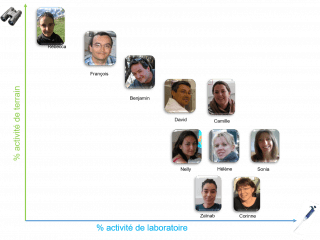Research assistance
Members

Assistante ingénieure
CNRS
Tel: 04 72 44 81 42

Ingénieure d'études
CNRS
Tel: 33 04 72 43 29 17
Technicien CDD
CNRS

Assistant ingénieur
UCBL
Adjointe technique
UCBL
Tel: 33 04 72 44 79 17

Assistant ingénieur
CNRS
Tel: 33 04 72 43 29 29

Assistante ingénieure
CNRS
Tel: 04 72 44 81 42
Stagiaire
CNRS

Ingénieure de recherche
CNRS
Tel: 33 04 72 43 29 14
Technicienne CDD
UCBL

Technicienne
UCBL
Tel: 33 04 72 43 29 15

Ingénieur d'études
CNRS
Tel: 33 04 72 44 58 72
Adjointe technique
UCBL
Tel: 04 72 44 81 42

Technicienne
CNRS
Tel: 04 72 44 81 42

Assistante ingénieure
UCBL
Tel: 04 72 43 29 14

Technicien
UCBL

Ingénieur de recherche
CNRS
Tel: 04 72 43 29 29

The “pole biotechnologique” brings together a range of bioengineering expertise for the development of tools and approaches for research in evolutionary biology; and operational competences to ensure their logistical and technical implementation.
Since it was set up, the biotechnology hub has perpetuated insect breeding activities, including several species of drosophila, but also Venturia and Bemisia for example. These breeding activities are carried out on artificial medium or plants. We ensure laboratory logistics (e.g. autoclave, stock management, ...) as well as safety aspects, and develop devices (e.g. via 3D printing) to feed experimental research in the laboratory focusing on evolutionary genomics, behavioural ecology and functional ecology.
Our expertise is also solicited to organize field work, in metropolitan France and internationally, and to carry out population monitoring of terrestrial mammals (e.g. roe deer, marmots, feral cats, bats) and birds (dipper). In addition to capture (e.g. trapping, netting), marking and monitoring of animals, we implement experimental approaches in natura, collect biometric, behavioral and physiological data, biological samples (blood, secretions, hair, faeces, biopsy, ...) and characterize the study environments (installation of sensors, aerial imaging by drones, construction of digital models of terrain ...).
Finally, the biotechnology hub offers the technical resources and skills to analyse a wide variety of biological samples in the laboratory through an multidisciplinary prism. The complementarity and synergy of our competences are expressed in the fields of molecular biology (PCR, qPCR, construction of libraries for the genesis of ohmic data), cell biology (confocal microscopy, flow cytometry), and biochemistry (characterization of metabolic, endocrine and oxidative profiles).
Rehabilitation work was done at the LBBE in 2022 and lead to a significant expansion of the experimental space. These new premises allow us to increase our capacity, to offer new spaces and modern tools dedicated to behavioral approaches. These new premises also allow us to widen the spectrum of our activities by developing new techniques (e.g. cell culture, Crispr/cas9, RNAi, ...).
In all our activities, we regularly welcome and supervise trainees and students of all levels. For any questions or information request, do not hesitate to contact us
Publications
Display of 121 to 150 publications on 259 in total
Deciphering the behaviour manipulation imposed by a virus on its parasitoid host: insights from a dual transcriptomic approach
Parasitology . 145 ( 14 ) : 1979-1989
Journal article
see the publicationDevelopment of a PCR-RFLP assay to identify Drosophila melanogaster among field-collected larvae
Ecology and Evolution . 8 ( 20 ) : 10067 - 10074
DOI: 10.1002/ece3.4453
Journal article
see the publicationEvaluating the essentiality of the primary endosymbiont of the rice weevil Sitophilus oryzae through genome analysis
6. Meeting of the Spanish Society for Evolutionary Biology (SESBE) .
Poster
see the publicationImmunosenescence patterns in two populations of a long-lived mammal.
Réunion du groupe Immuno-écologie du Réseau Ecologie des Interactions Durables .
Conference paper
see the publicationImmunosenescence patterns differ between populations but not between sexes in a long-lived mammal
Scientific Reports . 7 ( 1 )
Journal article
see the publicationGenome sequencing of the behaviour manipulating virus LbFV reveals a possible new virus family
Genome Biology and Evolution . 8 : 3718-3738
DOI: 10.1093/gbe/evw277
Journal article
see the publicationHigh-Throughput Sequencing of Transposable Element Insertions Suggests Adaptive Evolution of the Invasive Asian Tiger Mosquito Towards Temperate Environments
Molecular Ecology . 26 ( 15 ) : 1-14
DOI: 10.1111/mec.14184
Journal article
see the publicationMaternal age affects offspring nutrient dynamics
Journal of Insect Physiology . 101 : 123 - 131
Journal article
see the publicationAge-dependent associations between telomere length and environmental conditions in roe deer
Biology Letters . 13 ( 9 ) : 20170434
Journal article
see the publicationUncoupling effect of palmitate is exacerbated in skeletal muscle mitochondria of sea-acclimatized king penguins (Aptenodytes patagonicus)
Comparative Biochemistry and Physiology - Part A: Molecular and Integrative Physiology . 211 : 56-60
Journal article
see the publicationIdentification of misexpressed genetic elements in hybrids between Drosophila-related species
Scientific Reports . 7 : 40618
DOI: 10.1038/srep40618
Journal article
see the publicationMicrochip transponder thermometry for monitoring core body temperature of antelope during capture
Journal of Thermal Biology . 55 : 47-53
Journal article
see the publicationInfluenza vaccine effectiveness among healthcare workers in comparison to hospitalized patients: A 2004-2009 case-test, negative-control, prospective study
Human Vaccines & Immunotherapeutics . 12 : 485-90
Journal article
see the publicationFruiting Strategies of Perennial Plants: A Resource Budget Model to Couple Mast Seeding to Pollination Efficiency and Resource Allocation Strategies
The American Naturalist . 188 ( 1 ) : 66-75
DOI: 10.1086/686684
Journal article
see the publicationHormetic response triggers multifaceted anti-oxidant strategies in immature king penguins (Aptenodytes patagonicus)
Free Radical Biology and Medicine . 97 : 577–587
Journal article
see the publicationTranscriptomic data analysis and differential gene expression of antioxidant pathways in king penguin juveniles (Aptenodytes patagonicus) before and after acclimatization to marine life
Data in Brief . 9 : 549–555
Journal article
see the publicationLipid-induced thermogenesis is up-regulated by the first cold-water immersions in juvenile penguins
Journal of Comparative Physiology B . 186 : 639–650
Journal article
see the publicationFactors associated with poor outcomes among adults hospitalised for influenza in France: A three-year prospective multicenter study
Journal of Clinical Virology . 79 : 68–73
Journal article
see the publicationAdditional heritable virus in the parasitic wasp Leptopilina boulardi: prevalence, transmission and phenotypic effects
Journal of General Virology . 97 : 523-535
DOI: 10.1099/jgv.0.000360
Journal article
see the publicationInfluence of oxidative homeostasis on bacterial density and cost of infection in Drosophila–Wolbachia symbioses
Journal of Evolutionary Biology . 29 : 1211-1222
DOI: 10.1111/jeb.12863
Journal article
see the publicationThe draft genome sequence of the rice weevil Sitophilus oryzae as a model to explore the host-symbiont interactions in a nascent stage of endosymbiosis
Journées Ouvertes Biologie Informatique Mathématiques (JOBIM) .
Poster
see the publicationStrong phylogenetic inertia on genome size and transposable element content among 26 species of flies
Biology Letters . 12 ( 8 )
Journal article
see the publicationDrosophila Females Undergo Genome Expansion after Interspecific Hybridization
Genome Biology and Evolution . 8 ( 3 ) : 556-561
DOI: 10.1093/gbe/evw024
Journal article
see the publicationIs genome size of Lepidoptera linked to host plant range?
Entomologia Experimentalis et Applicata . 159 ( 3 ) : 354-361
DOI: 10.1111/eea.12446
Journal article
see the publicationBeneficial effects of group size on oxidative balance in a wild cooperative breeder
Behavioral Ecology . 27 ( 6 ) : 1820–1825
Journal article
see the publicationVariation in the link between oxygen consumption and ATP production, and its relevance for animal performance
Proceedings of the Royal Society B: Biological Sciences . 282 : 14-22
Journal article
see the publicationTwo Host Clades, Two Bacterial Arsenals: Evolution through Gene Losses in Facultative Endosymbionts.
Genome Biology and Evolution . 7 ( 3 ) : 839-855
DOI: 10.1093/gbe/evv030
Journal article
see the publicationOxidative phosphorylation efficiency, proton conductance and reactive oxygen species production of liver mitochondria correlates with body mass in frogs
Journal of Experimental Biology . 218 : 3222-3228
DOI: 10.1242/jeb.126086
Journal article
see the publicationDetection of genetically isolated entities within the Mediterranean species of Bemisia tabaci: new insights into the systematics of this worldwide pest
Pest Management Science . 71 ( 3 ) : 452-458
DOI: 10.1002/ps.3834
Journal article
see the publicationOptimization of multiplexed RADseq libraries using low-cost adaptors
Genetica . 143 ( 2 ) : 139-143
Journal article
see the publication